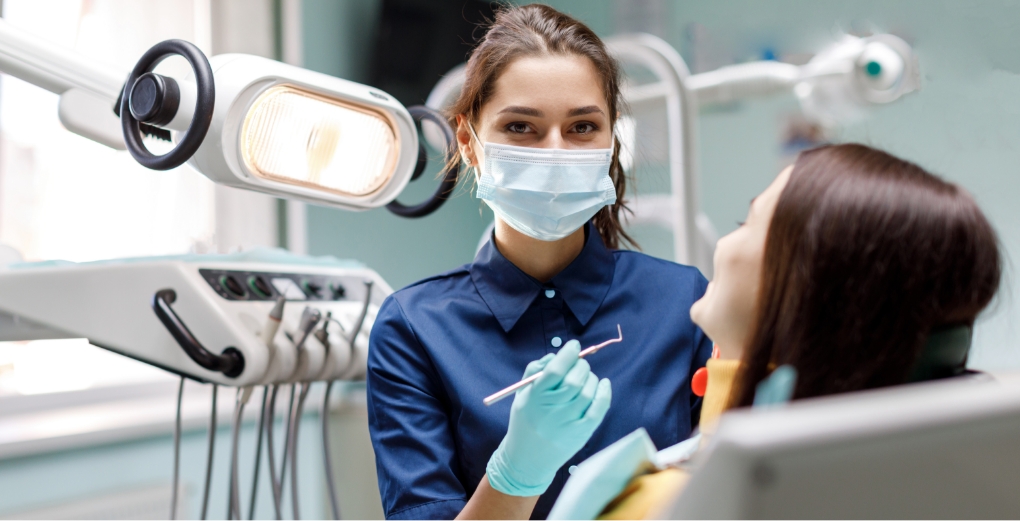Dental X-rays
Dental X-rays, also known as dental radiographs, are diagnostic tools commonly used in dentistry to visualize the internal structures of the teeth, jaws, and surrounding tissues. These images provide valuable information that helps dentists assess and diagnose various oral health issues that might not be visible through a simple visual examination.
How Do Dental X-rays Work?
Dental X-rays work on the principle of differential absorption of X-ray beams by various oral structures. When the X-ray machine emits a focused beam of radiation through the mouth, the X-rays pass through soft tissues like gums and cheeks with minimal resistance. However, denser structures such as teeth and bones absorb more X-rays.
A digital sensor or X-ray film positioned behind the oral structures captures the X-rays that pass through. The captured X-rays create an image that displays variations in X-ray absorption.
Areas where X-rays are absorbed more, like tooth enamel and bone, appear lighter, while areas with less absorption, like cavities or gaps, appear darker. Dentists can interpret these images to detect abnormalities, diagnose dental issues, and plan treatments effectively.
Detectable Problems through Dental X-Rays
Dental X-rays are invaluable tools for identifying a range of oral health problems that may not be visible to the naked eye. Some of the issues that can be detected through dental X-rays include:
- Cavities: X-rays can reveal cavities between teeth or beneath existing dental work, aiding in early detection and treatment.
- Bone Loss: X-rays help assess the level of bone supporting the teeth, essential for diagnosing conditions like periodontal disease.
- Infections: X-rays can identify infections such as abscesses, cysts, or dental infections that may not be evident visually.
- Impacted Teeth: X-rays reveal teeth that are unable to erupt properly due to obstruction by other teeth or bone.
- Developmental Issues: X-rays assist in monitoring the development of teeth and jaws, particularly in children.
- Orthodontic Planning: X-rays aid orthodontists in planning treatments by showing tooth alignment and jaw positioning.
- Tumors: X-rays can help identify tumors or abnormal growths within the oral structures.
Procedure of Dental X-rays
The procedure for dental X-rays involves the following steps:
- Preparation: Before the X-ray, the patient may need to wear a lead apron to protect against unnecessary radiation exposure. The dentist positions the X-ray film or digital sensor in the mouth as needed.
- X-ray Exposure: The X-ray machine is adjusted to the specific area being examined. The patient is asked to hold still while the X-ray is taken, which usually requires only a few seconds.
- Processing: For traditional X-rays, the film needs to be developed using chemicals. In the case of digital X-rays, the captured image is instantly available on a computer screen.
- Interpretation: The dentist analyzes the X-ray images, looking for any abnormalities, decay, bone loss, or other issues.
- Diagnosis and Treatment: Based on the X-ray findings, the dentist develops a diagnosis and treatment plan if necessary. If issues are detected, further steps like fillings, extractions, or other treatments may be recommended.
Types of Dental X-rays
There are several types of dental X-rays, each designed to capture specific views of the oral structures. These types include:
- Bitewing X-rays: These X-rays focus on the crowns of the upper and lower back teeth and are useful for detecting cavities between teeth and monitoring changes over time.
- Periapical X-rays: These capture the entire tooth, from crown to root, and help identify issues such as abscesses, infections, and bone changes around the tooth.
- Panoramic X-rays: Panoramic X-rays provide a wide view of the entire mouth, showing all teeth, jaws, and surrounding structures. They’re useful for assessing overall oral health and planning orthodontic treatments.
- Occlusal X-rays: These reveal the bite of the upper and lower jaw, and are particularly helpful in detecting developmental issues in children.
- Cone Beam Computed Tomography (CBCT): CBCT is a 3D imaging technique that provides highly detailed views of teeth, bones, and soft tissues. It’s often used for complex procedures like implant placements and orthodontic planning.
- Extraoral X-rays: These include panoramic and cephalometric X-rays that capture a broader view of the head and neck. Cephalometric X-rays are commonly used in orthodontics to assess facial growth and skeletal proportions.
- Caries Risk Assessment X-rays: These are specialized X-rays used to assess a patient’s risk for developing cavities and guide preventive measures.
Safety of Dental X-rays
Dental X-rays are generally considered safe, with modern technology minimizing radiation exposure. Dentists follow strict guidelines to ensure patient safety:
- Lead Aprons and Collars: Patients are typically provided with lead aprons and collars to shield sensitive tissues from unnecessary radiation.
- Digital Technology: Digital X-rays significantly reduce radiation exposure compared to traditional film X-rays.
- As Low As Reasonably Achievable (ALARA) Principle: Dentists adhere to this principle by using the lowest radiation dose necessary to obtain diagnostically useful images.
- Pregnancy Precautions: Pregnant patients are advised to postpone non-emergency X-rays to avoid any potential risk to the developing fetus.
- X-ray Evaluation Necessity: Dentists consider a patient’s oral health needs and medical history before recommending X-rays.
Recommended Frequency of Dental X-rays
The frequency of dental X-rays varies based on factors such as a patient’s age, oral health status, risk factors, and history of dental issues. Generally, these are the guidelines:
- Children: Children often require X-rays more frequently due to their developing teeth and jaws. Bitewing X-rays may be taken once a year, and panoramic X-rays every 3-5 years.
- Adults: For adults with good oral health, bitewing X-rays every 1-2 years and panoramic X-rays every 5-10 years are typical.
- High-Risk Patients: Those with a history of dental problems, frequent cavities, or gum disease might need X-rays more often.
Optimal Teeth X-Raying Frequency
The optimal frequency for X-rays depends on individual circumstances. Dentists assess factors like age, oral health, medical history, and risk factors to determine how often X-rays should be taken. It’s important to follow your dentist’s recommendations and discuss any concerns you might have.
Dental X-Ray Schedule for Children, Adolescents, and Adults
- Children: Children often start with X-rays around age 5-7. Bitewing X-rays are usually taken every 6-12 months, and panoramic X-rays may be taken every 3-5 years.
- Adolescents: As permanent teeth develop, X-rays help monitor their growth and detect issues. Bitewing X-rays are typically taken annually, and panoramic X-rays every 3-5 years.
- Adults: For those with good oral health, bitewing X-rays are taken every 1-2 years. Panoramic X-rays may be taken every 5-10 years to monitor overall oral health.
Risks Associated with Dental X-rays
While dental X-rays are considered safe, there are some potential risks to be aware of:
- Radiation Exposure: X-rays involve a small amount of radiation. Modern technology and safety measures minimize exposure, but repeated X-rays over time could accumulate radiation.
- Pregnancy Concerns: Pregnant women should avoid unnecessary X-rays, especially during the first trimester, as there’s a slight risk to the developing fetus. Inform your dentist if you’re pregnant.
- Radiation Sensitivity: Some individuals might be more sensitive to radiation due to underlying health conditions. It’s important to inform your dentist about your medical history.
- Thyroid Exposure: The thyroid gland is sensitive to radiation. A thyroid collar or lead apron is often used during X-rays to shield this area.
- X-ray Overuse: Excessive X-rays without a clinical need can lead to unnecessary radiation exposure. Dentists follow guidelines to ensure X-rays are only taken when necessary.
Preparation for Dental X-rays
To ensure the best X-ray results and a smooth procedure, consider the following preparations:
- Clothing: Wear comfortable clothing that can easily be adjusted to accommodate the X-ray equipment.
- Jewelry and Accessories: Remove any jewelry, eyeglasses, or accessories that might interfere with the X-ray process.
- Inform Your Dentist: Inform your dentist of any medical conditions, recent surgeries, or ongoing treatments. Also, disclose if you’re pregnant or suspect you might be.
- Dental History: Share your dental history, including previous X-rays and oral health issues, to help the dentist determine the appropriate X-rays to take.
- Questions and Concerns: Don’t hesitate to ask your dentist any questions or express concerns you might have about the X-ray procedure.
Post Dental X-ray Care
After getting dental X-rays, there are generally no specific post-procedure steps to follow. However, you can consider the following:
- Resume Normal Activities: You can resume your regular activities immediately after the X-ray procedure.
- Maintain Hygiene: Continue your regular oral hygiene routine, including brushing and flossing, to keep your teeth and gums healthy.
- Follow Dentist Recommendations: If your dentist identifies any issues based on the X-rays, follow their recommendations for further treatment or preventive measures.
- Monitor for Symptoms: While rare, if you experience any unusual symptoms after X-rays, such as swelling, discomfort, or skin irritation, contact your dentist.
- X-ray Records: Keep a copy of your X-ray records for reference in future dental visits or if you change dentists.
Conclusion
In conclusion, dental X-rays are invaluable tools in modern dentistry, providing detailed insights into oral health that aid in accurate diagnoses and effective treatment planning. While there are minimal risks associated with radiation exposure, advancements in technology and safety measures have significantly reduced these concerns.
Find a location


